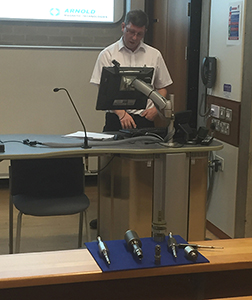UK Magnetics Society "Magnetic Materials" conference, Birmingham, UK

The UK Magnetics Society meeting was held at the University of Birmingham, and showcased developments across a broad range of magnetic materials including rare earth permanent magnets (REPMs). The scope of the meeting was very broad, including soft magnets, permanent magnets, recording media, magnetocalorics, magnetic nanoparticles and measurement techniques.
For SoS RARE it is important that we understand the life-cycle of REE from “cradle to grave”, including developments in materials science and in the industries that are ultimately the developers and end users of the critical rare earths. In terms of value and rate of growth REPMs are the strongest sector for REE application.
A varied audience attended with delegates from the Universities of Birmingham, Cambridge, Cardiff, Swansea, Newcastle, Sheffield, Warwick, and the National Physics Laboratory as well as industry attendees including Gareth Hatch from Technology Metals Research, and representatives from Arnold Magnetic Technologies, CamFridge, Less Common Metals, Vacuumschmelze GmbH, MAGNET-PHYSIK, Magdev Ltd., and Eclipse Magnetics Ltd.
An introduction by Professor Rex Harris of the University of Birmingham highlighted the importance of "de-carboning" our society and showed that the physical qualities of neodymium-iron-boron (NdFeB) and samarium-cobalt (SmCo) magnets have enabled us to move towards a low-carbon future. Importantly, there is a need to narrow the gaps between mining and separation of the REE. Pricing crises have led to some end-users switching from REPM motors to induction motors (magnet free – as in Tesla cars for example). But REPMs are still by far the most energy efficient and adaptable design. There is a need to convince industry and policy that supply issues can be addressed.
Recent years' metallurgical advances have helped to reduce the amount of Dy added to NdFeB magnets (to enable magnets to work at higher operating temperatures), either by melt-spin ribbon casting (to increase coercivity), or by spraying gas atomised powders of Dy into the NdFeB mix -requiring smaller amounts of Dy.
Allan Walton of the School of Metallurgy and Materials, University of Birmingham, and chair of the UK Magnetics Society, followed on by introducing developments in end-of-life REPM recycling under the H2020 REProMag "Resource Efficient Production of Magnets" and FP7 Remanence umbrellas. We saw the hydrogenation process showcased when the SoS RARE project was in its catalyst phase in October 2013. It was impressive to see this advancing into robotic sorting and processing, and milling to remove Ni coatings from the hard-drive magnets. Recasting and re-sintering of the recycled materials are undertaken by Less Common Metals (who have been bought by Indian Ocean Rare Metals after the fold-up of Great Western Mining Group). Recycled material is more "porous" - this grain boundary issue has been addressed by dusting of "fresh" Nd to fill the grain boundaries to prevent the loss of coercivity.
Roger Allcock, of Arnold Magnetic Technologies Ltd, followed on from Allan to showcase applications of SmCo magnets. From a very practical basis SmCo have high temperature properties and resistance to corrosion. SmCo magnets are mainly used where NdFeB magnets cannot operate as efficiently – for example RECOMA 35-E SmCo magnets are used in motorsport applications (Formula 1, Formula-E), road-car turbos, and in aerospace applications. Feedstock for these magnets is subject to supply issues not only for Sm, but also for Co which is a critical metal. Arnold Magnetics are currently involved in a joint venture with Guanzhou Rare Earth Group. Out of interest, the standard proportions in a Sm2Co17 magnet are as follows: Co 47%, Sm 25%, Fe 18%, Cu 5%, Zr 5%.
Alessandro Pastore of magnetic refrigeration pioneers Camfridge Ltd showcased their domestic magnetic refrigeration units. The technology harnesses magnetocalorific differentials to produce highly efficient cooling, as a proven alternative to the standard gas compressors in domestic fridges. The company is backed by FP7, UK Trade & Investment, Cambridge Capital Group, University of Cambridge Enterprise, Oxford Trust, and NESTA. The scale of the impact of this technology is high with partners already including BEKO, Whirlpool and Indesit. This technology will require significant (and reliable) feedstocks of La (in the magnetocalorific component) and Nd (in the motor component). Circa 2kg of La and Nd are present in each unit (proportions not divulged). Interestingly, as these fridges will be operating at room temperature (requiring lower coercivity magnets) they could use recycled REPMs.
In conclusion, there are exciting growth areas for REE applications, both for existing technologies and burgeoning ones, again underlying the need for diverse and secure supply of these vital elements, but with reassurance in sustainability with the advances in recycling.
Ed Loye, July 2016






